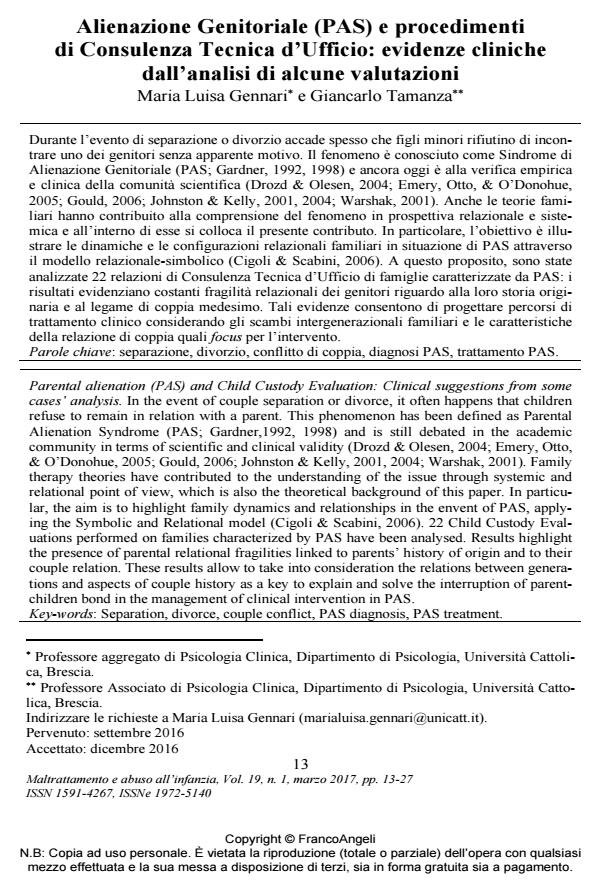Parental alienation (PAS) and Child Custody Evaluation: Clinical suggestions from some cases’ analysis
Journal title MALTRATTAMENTO E ABUSO ALL’INFANZIA
Author/s Maria Luisa Gennari, Giancarlo Tamanza
Publishing Year 2017 Issue 2017/1
Language Italian Pages 15 P. 13-27 File size 202 KB
DOI 10.3280/MAL2017-001002
DOI is like a bar code for intellectual property: to have more infomation
click here
Below, you can see the article first page
If you want to buy this article in PDF format, you can do it, following the instructions to buy download credits

FrancoAngeli is member of Publishers International Linking Association, Inc (PILA), a not-for-profit association which run the CrossRef service enabling links to and from online scholarly content.
In the event of couple separation or divorce, it often happens that children refuse to remain in relation with a parent. This phenomenon has been defined as Parental Alienation Syndrome (PAS; Gardner,1992, 1998) and is still debated in the academic community in terms of scientific and clinical validity (Drozd & Olesen, 2004; Emery, Otto, & O’Donohue, 2005; Gould, 2006; Johnston & Kelly, 2001, 2004; Warshak, 2001). Family therapy theories have contributed to the understanding of the issue through systemic and relational point of view, which is also the theoretical background of this paper. In particular, the aim is to highlight family dynamics and relationships in the envent of PAS, applying the Symbolic and Relational model (Cigoli & Scabini, 2006). 22 Child Custody Evaluations performed on families characterized by PAS have been analysed. Results highlight the presence of parental relational fragilities linked to parents’ history of origin and to their couple relation. These results allow to take into consideration the relations between generations and aspects of couple history as a key to explain and solve the interruption of parent-children bond in the management of clinical intervention in PAS.
Keywords: Separation, divorce, couple conflict, PAS diagnosis, PAS treatment.
- The Clinical Generational Interview. An instrument for family assessment Giancarlo Tamanza, Marialuisa Gennari, in Frontiers in Psychology 1361028/2024
DOI: 10.3389/fpsyg.2024.1361028 - The associations for separated parents in Italy: Their role for parents’ well-being and coparenting Anna Bertoni, Elisabetta Carrà, Raffaella Iafrate, Alice Zanchettin, Miriam Parise, in Health & Social Care in the Community /2018 pp.e571
DOI: 10.1111/hsc.12573 - The Conjoint Family Drawing: A Tool to Explore About Family Relationships Marialuisa Gennari, Giancarlo Tamanza, in Frontiers in Psychology 884686/2022
DOI: 10.3389/fpsyg.2022.884686 - La consultazione clinica con coppie altamente conflittuali Giancarlo Tamanza, Marialuisa Gennari, Carles Perez Testor, in RICERCHE DI PSICOLOGIA 4/2019 pp.713
DOI: 10.3280/RIP2018-004010 - Court-appointed expert consultation in Italy: an ethnographic study of parents’ beliefs, expectations, and experiences Antonio Iudici, Francesca Rainieri, Tania Fiorini, in Frontiers in Psychology 1668693/2025
DOI: 10.3389/fpsyg.2025.1668693 - Caratteristiche psicologiche e relazionali in coppie altamente conflittuali coinvolte nell'alienazione genitoriale Maria Cristina Verrocchio, Daniela Marchetti, Paolo Roma, Stefano Ferracuti, in RICERCHE DI PSICOLOGIA 4/2019 pp.679
DOI: 10.3280/RIP2018-004008 - “Doubly Mother”: Heterologous Artificial Insemination Between Biological and Social Parenthood: A Single Case Study Giancarlo Tamanza, Federica Facchin, Federica Francini, Silvia Ravani, Marialuisa Gennari, Giuseppe Mannino, in World Futures /2019 pp.480
DOI: 10.1080/02604027.2019.1654769 - Caratteristiche dinamiche e funzionali della fase costitutiva della coppia Marialuisa Gennari, Giancarlo Tamanza, in RICERCHE DI PSICOLOGIA 4/2019 pp.615
DOI: 10.3280/RIP2018-004005 - A Comparison of MMPI-2 Profiles Between Parental Alienation Cases and Custody Cases Paolo Roma, Daniela Marchetti, Cristina Mazza, Eleonora Ricci, Lilybeth Fontanesi, Maria Cristina Verrocchio, in Journal of Child and Family Studies /2022 pp.1196
DOI: 10.1007/s10826-021-02076-1 - MMPI-2 Profiles of Mothers Engaged in Parental Alienation Paolo Roma, Daniela Marchetti, Cristina Mazza, Franco Burla, Maria Cristina Verrocchio, in Journal of Family Issues /2021 pp.722
DOI: 10.1177/0192513X20918393 - Intimate Partner Violence and Child Custody Evaluation: A Model for Preliminary Clinical Intervention Marialuisa Gennari, Giancarlo Tamanza, Sara Molgora, in Frontiers in Psychology 1471/2018
DOI: 10.3389/fpsyg.2018.01471
Maria Luisa Gennari, Giancarlo Tamanza, Alienazione Genitoriale (PAS) e procedimenti di Consulenza Tecnica d’Ufficio: evidenze cliniche dall’analisi di alcune valutazioni in "MALTRATTAMENTO E ABUSO ALL’INFANZIA" 1/2017, pp 13-27, DOI: 10.3280/MAL2017-001002